Calulu de peixe is an Angolan fish and vegetable stew with an interesting, yet somber origin. The history of this stew can be traced back centuries, to the time of the colonial slave trade.
Two ingredients in calulu de piexe, okra and palm oil, each have their own interesting story to tell. Okra’s story is one of a mysterious transcontinental journey. The story of palm oil is much more controversial.
Let’s uncover the history of Calulu and okra, then we’ll journey from Angola to Indonesia to explore ethically sourced palm oil.

Calulu de Peixe: The Trans-Atlanic Voyage, Okra and the Straits of Gibraltar, and Sustainable Palm Oil
Calulu de peixe has the interesting distinction that, while it’s very much a traditional Angolan dish, it didn’t really originate in Angola. In fact, it was created half a world away from the country.
From Angola to Brazil… and Back Again
Technically, the recipe for calulu de peixe is a Brazilian invention. Originally called caruru, the dish started in the New World among the slave population, but it eventually made its way to Angola aboard Portuguese ships.
Even so, there’s always been an indelible Angolan imprint on the dish from the start. Between the 1500s-1800s, the Portuguese consistently brought Angolans in order to supply their labor needs in their new colony. Along with the slaves came elements of their culture that has deeply influenced Brazilian culture, even to this day.
The Angolan influence on Brazilian culture can be especially felt in the cuisine. People taken from Angola brought culinary knowledge and ingredients like okra with them. As the culture in Brazil began to evolve with the arrival of the Portuguese and their Angolese slaves, new techniques yielded new dishes featuring these African ingredients, one such dish being calulu de peixe.
An Angolan Stew With Fish, Okra and Palm Oil
Calulu de peixe is an Angolan fish and vegetable stew with an interesting, yet somber origin. The history of this stew can be traced back centuries, to the time of the colonial slave trade.
Two ingredients in calulu de piexe, okra and palm oil, each have their own interesting story to tell. Okra’s story is one of a mysterious transcontinental journey. The story of palm oil is much more controversial.
Let’s uncover the history of Calulu and okra, then we’ll journey from Angola to Indonesia to explore ethically sourced palm oil.
About the Recipe
When it comes to actually preparing calulu de peixe, there’s actually very little that you actually need to do. From the marinating to the stewing, this recipe involves more standing by than it does your active involvement.
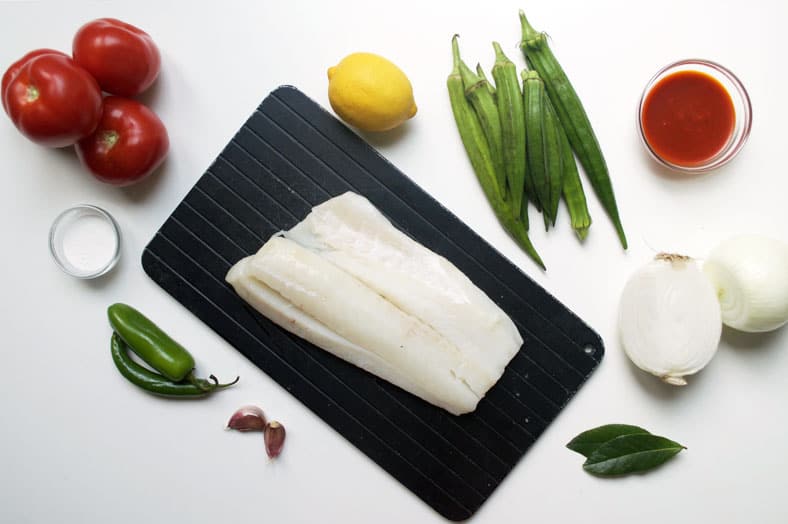
Calulu de peixe starts with the key protein in the dish: the fish (peixe in Portuguese). Unlike what you’ll see in the recipe below, calulu is most traditionally made with dried fish. Any type of fish – fresh, dried, salted or smoked – is technically allowed, but dried fish is the most common way to go. If you do use dried fish, though, then you’ll want to pre-soak it and wash off any potential salt prior to cooking.
You’ll first marinate the fish in a mixture of lemon juice, salt and pepper. Especially if you’re using dried fish, the lemon juice will help soften it and remove toughness before you place it in the pot to create your stew.

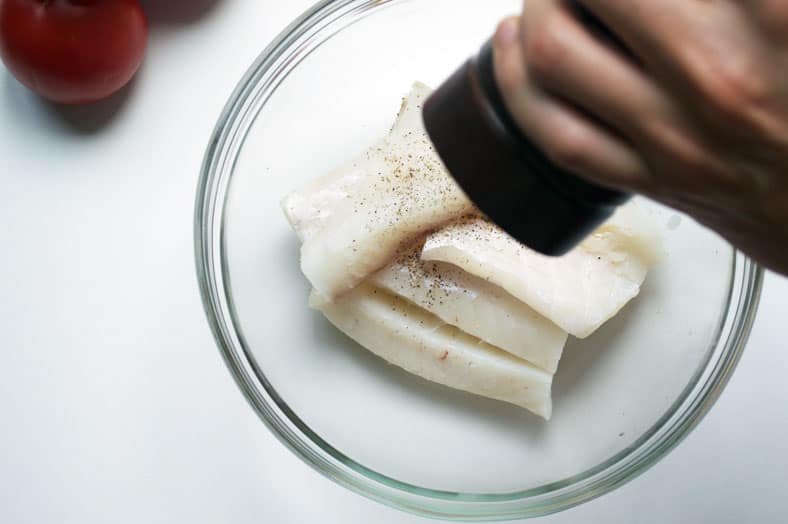
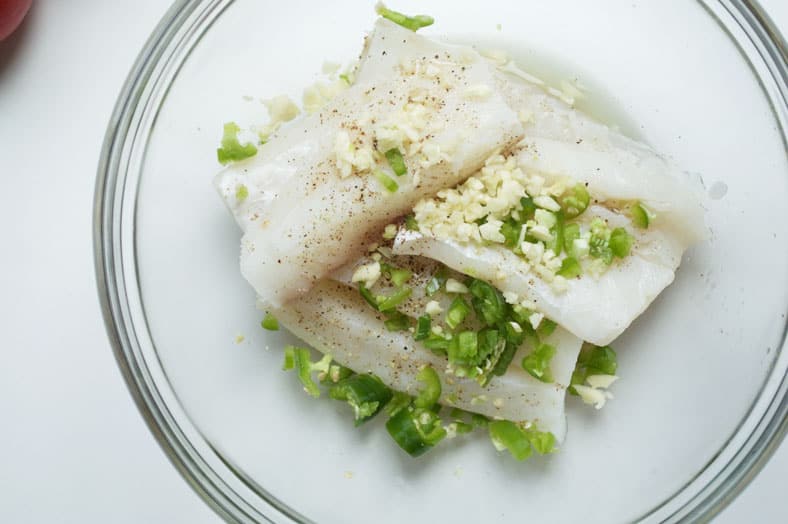
As your fish marinates, you’ll start the stew itself by sautéing and lightly pre-cooking your vegetable ingredients. Cook things like onions and garlic for a minute as they start to sweat and become translucent, then you’ll begin creating alternate layers of your remaining ingredients including your okra and fish.

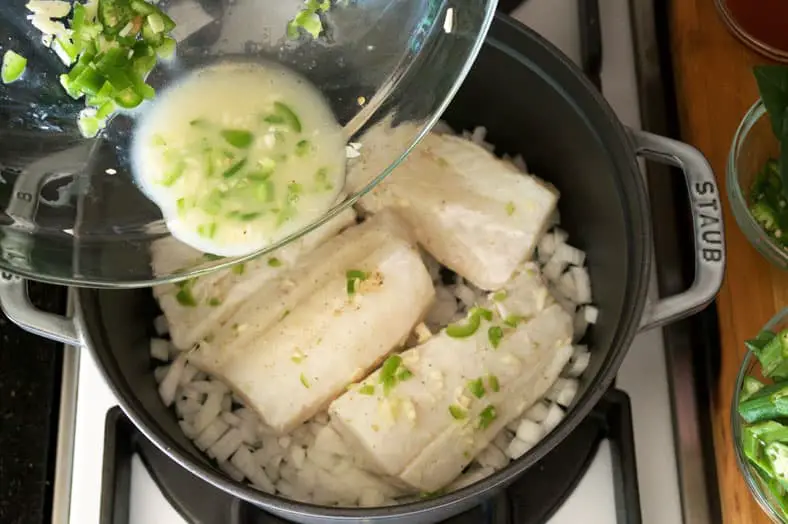
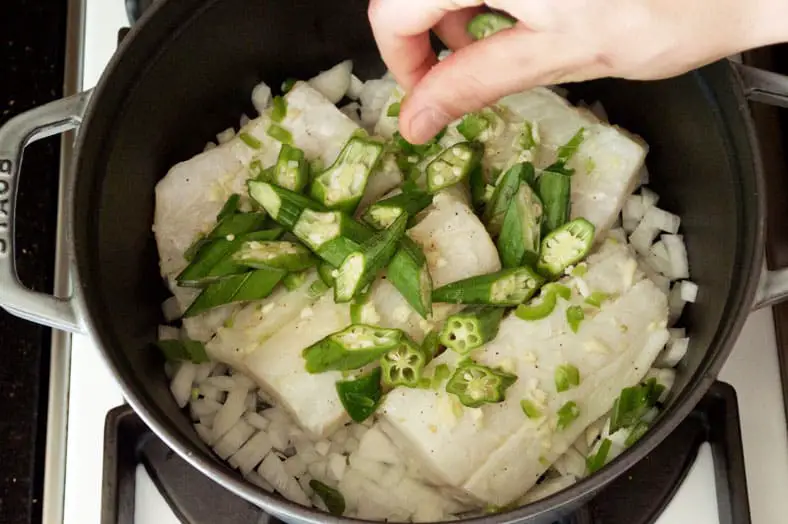
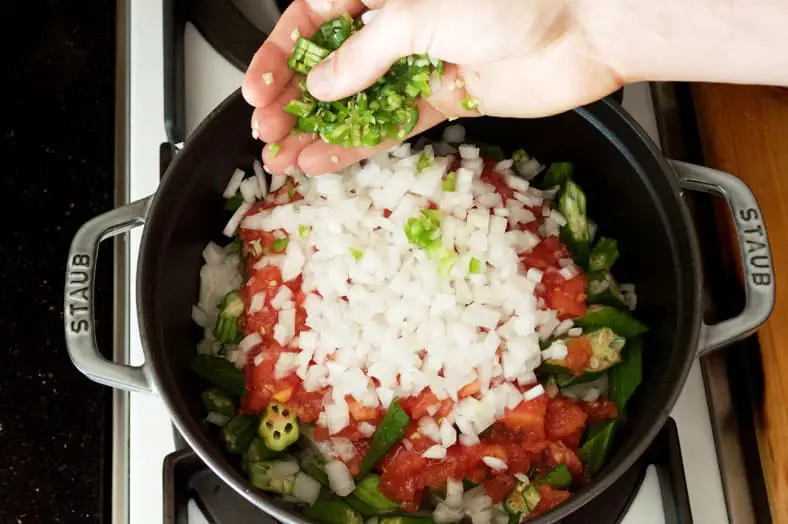

Once you have a multi-layer mound of mixed ingredients, pour your palm oil over top . Be sure to pour evenly, since this will help the red palm oil spread evenly throughout the calulu during cooking.

Following the palm oil, add enough vegetable broth or water to submerge your ingredients, then cover your pot and let cook for at least 20 minutes. Towards the tail end, you’ll add in your leafy greens and let them cook just before serving.


When done, calulu de peixe traditionally pairs well with funje, a cassava porridge, or white rice, but it’s also just as good on its own!
Our Take on the Recipe
As prevalent as calulu de peixe is in Angolan cuisine, we had some real trouble finding quality reference recipes that painted a good picture of how the dish should be. Nevertheless, we found one to go off of, and from there we recreated the best we could.
We did make some fairly big changes to our version of the recipe overall. For starters, we chose to use fresh fish instead of dried fish in our recipe. Dried fish can have a very unique and interesting flavor – and it does give the broth for calulu a nice briney flavor – but it’s generally more trouble than it’s worth. Fresh fish, on the other hand, is much easier to use and easier to come by, which is what we prefer anyways.
Using fresh fish had a profound implication on the overall preparation of the recipe too. Whereas dried fish makes the prep of this recipe hours-long, fresh fish allowed us to cut the amount of cooking time needed down to just around 20 minutes.
To let the fish and okra feature more in the dish, we removed much of the added ingredients that our reference put forth. We omitted the eggplants, left out the jimboa leaves and spinach, and scaled down the amount of other leafy greens. And instead of collared greens, we used kale.
Finally, we also made minor adjustments to scale down the red palm oil and thickening agent for this calulu. Given that okra itself acts as a great thickener for soups and stews, we instead preferred to use more okra and less other ingredients where needed.
All in all, calulu de peixe is a simple meal that will leave you wondering how just a handful of key ingredients can yield such a diverse, rich flavor. Enjoy!
How would you prepare your own calulu de peixe? Would you use dried fish? Comment below!


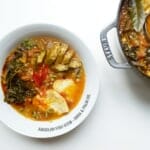
Calulu De Peixe Angolan Fish Vegetable Stew
- Total Time: 45 mins
- Yield: 4 people 1x
Ingredients
- 1 pound of fish (can be smoked, dried, fresh or a combo of all three)
- 3 garlic cloves, minced
- 2 medium-sized white onions, diced
- 3–4 medium-sized tomatoes, diced (keep the juices!)
- 1–2 green chili peppers, very finely chopped (optional, but very recommended)
- 2 handfuls (1/2 cup) okra, trimmed and sliced diagonally
- 1 cup kale, chopped
- 1 tablespoon lemon juice
- 2 bay leaves
- 1 teaspoon sea salt
- 1 teaspoon freshly cracked black pepper
- ¼ cup red palm oil
- 1½ cups vegetable broth
- 2 teaspoons arrowroot starch or similar sauce thickener (optional)
Instructions
- Take a medium-sized mixing bowl and place your fish in the center
- Pour your lemon juice, garlic and half of your green chili peppers over top, followed by salt and fresh cracked black pepper. Mix everything around, then let the fish sit in this marinade for 10 minutes
- Towards the tail end of the 20 minutes, begin the next stage by taking a stockpot over medium high heat with a dash of oil
- Start by adding your half of your diced onions into the pot and cooking for 1-2 minutes until translucent. Keep the other half aside for the layering to come
- Next, reduce your stovetop to a medium heat. Take your fish and layer it on top of the onions. Make sure the garlic and chili peppers make it from the bowl to the stockpot as well!
- Continue to layer your ingredients on top of the fish. Start with the okra, then the tomatoes, then more onions and green chili peppers on top
- After layering your ingredients, drizzle the red palm oil evenly over top the entire pile
- Add your vegetable broth to submerge all the ingredients, then cover your stockpot and cook your calulu for 15 minutes
- After 15 minutes, reduce your stovetop heat to a simmer, uncover the calulu and give it a stir
- Next, add in your chopped kale and stir again
- Optional: At this point, you can thicken the calulu for a richer consistency. To do this, dissolve your arrowroot starch in water to create a slurry, then pour the slurry into the stockpot
- Stir well, re-cover the stockpot and simmer for another 4-5 minutes, then you’re done!
- Prep Time: 20 mins
- Cook Time: 25 mins
- Cuisine: Angolan

